Financial Accounting Principles Report: Stakeholders and Entries
VerifiedAdded on 2021/02/20
|27
|3359
|93
Report
AI Summary
This report provides a comprehensive overview of financial accounting principles, beginning with an introduction to the subject and its objectives. It then delves into the analysis of internal and external stakeholders, detailing their roles and interests in a business entity. The report includes practical examples such as entry recording within relevant ledgers, the preparation of financial statements (revenue and balance sheet), and the application of accounting concepts like consistency and prudence. It also covers depreciation, the differences in financial statements between proprietors and companies, bank reconciliation statements, sales and purchase control accounts, and suspense accounts. The report concludes with a discussion of journal entries and a trial balance, providing a complete understanding of financial accounting practices.
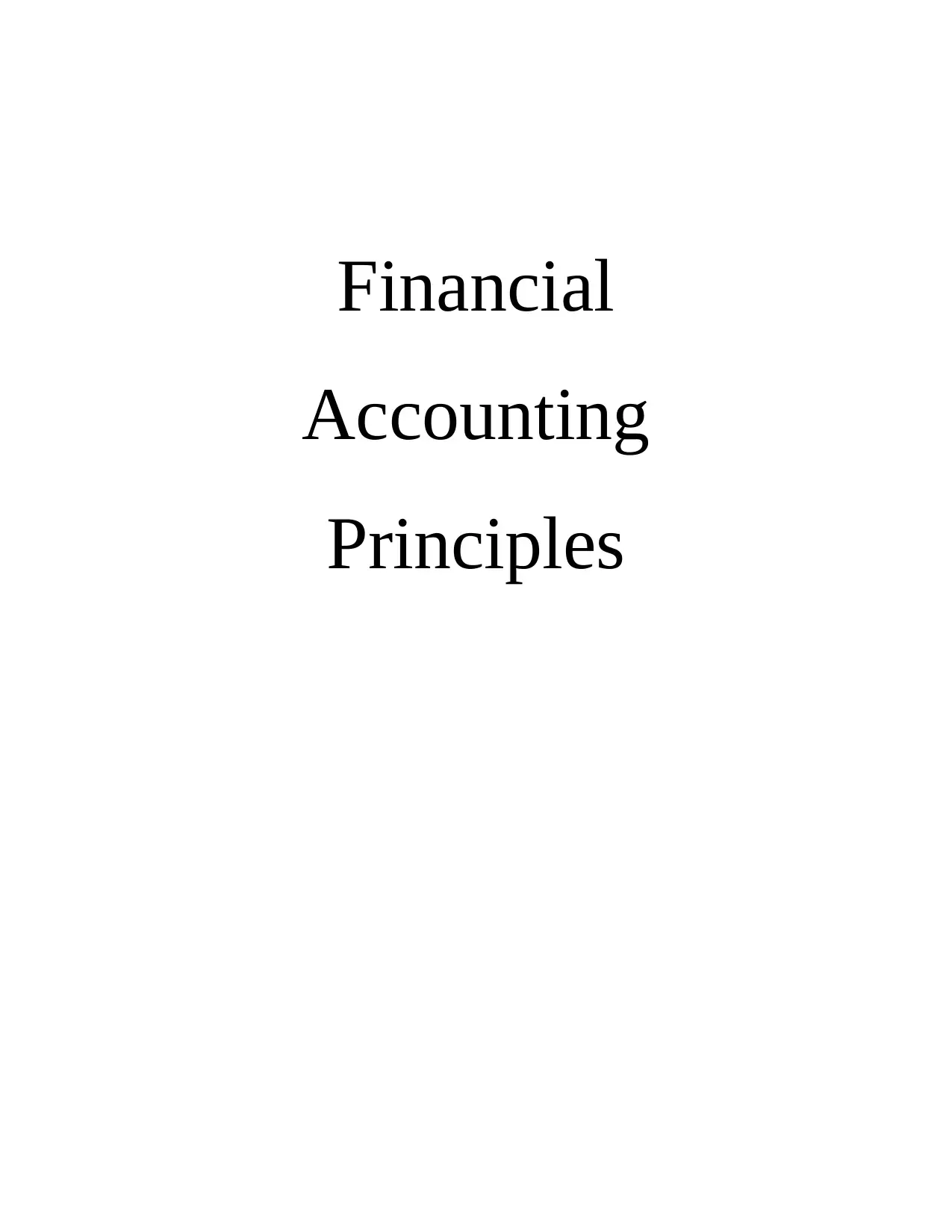
Financial
Accounting
Principles
Accounting
Principles
Paraphrase This Document
Need a fresh take? Get an instant paraphrase of this document with our AI Paraphraser
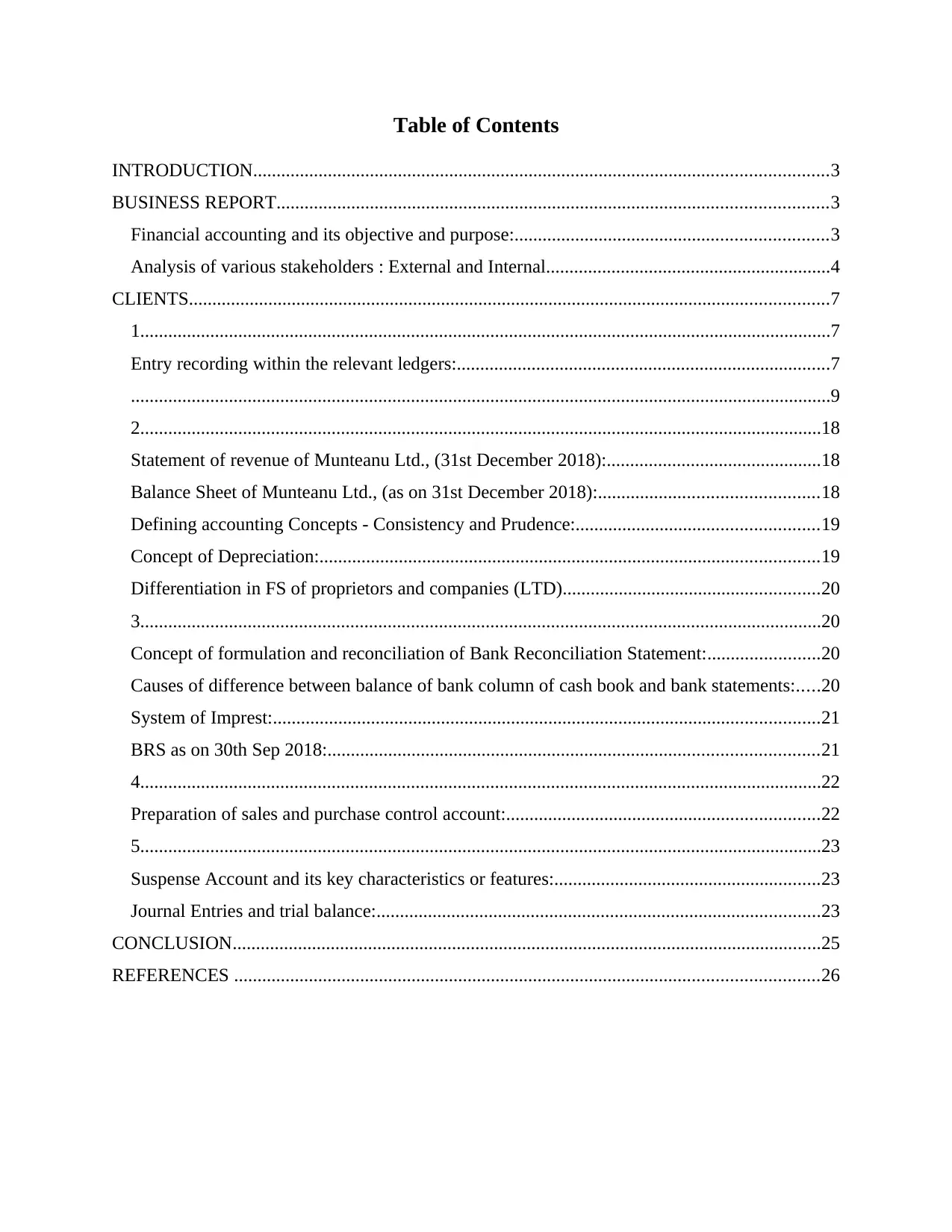
Table of Contents
INTRODUCTION...........................................................................................................................3
BUSINESS REPORT......................................................................................................................3
Financial accounting and its objective and purpose:...................................................................3
Analysis of various stakeholders : External and Internal.............................................................4
CLIENTS.........................................................................................................................................7
1....................................................................................................................................................7
Entry recording within the relevant ledgers:................................................................................7
......................................................................................................................................................9
2..................................................................................................................................................18
Statement of revenue of Munteanu Ltd., (31st December 2018):..............................................18
Balance Sheet of Munteanu Ltd., (as on 31st December 2018):...............................................18
Defining accounting Concepts - Consistency and Prudence:....................................................19
Concept of Depreciation:...........................................................................................................19
Differentiation in FS of proprietors and companies (LTD).......................................................20
3..................................................................................................................................................20
Concept of formulation and reconciliation of Bank Reconciliation Statement:........................20
Causes of difference between balance of bank column of cash book and bank statements:.....20
System of Imprest:.....................................................................................................................21
BRS as on 30th Sep 2018:.........................................................................................................21
4..................................................................................................................................................22
Preparation of sales and purchase control account:...................................................................22
5..................................................................................................................................................23
Suspense Account and its key characteristics or features:.........................................................23
Journal Entries and trial balance:...............................................................................................23
CONCLUSION..............................................................................................................................25
REFERENCES .............................................................................................................................26
INTRODUCTION...........................................................................................................................3
BUSINESS REPORT......................................................................................................................3
Financial accounting and its objective and purpose:...................................................................3
Analysis of various stakeholders : External and Internal.............................................................4
CLIENTS.........................................................................................................................................7
1....................................................................................................................................................7
Entry recording within the relevant ledgers:................................................................................7
......................................................................................................................................................9
2..................................................................................................................................................18
Statement of revenue of Munteanu Ltd., (31st December 2018):..............................................18
Balance Sheet of Munteanu Ltd., (as on 31st December 2018):...............................................18
Defining accounting Concepts - Consistency and Prudence:....................................................19
Concept of Depreciation:...........................................................................................................19
Differentiation in FS of proprietors and companies (LTD).......................................................20
3..................................................................................................................................................20
Concept of formulation and reconciliation of Bank Reconciliation Statement:........................20
Causes of difference between balance of bank column of cash book and bank statements:.....20
System of Imprest:.....................................................................................................................21
BRS as on 30th Sep 2018:.........................................................................................................21
4..................................................................................................................................................22
Preparation of sales and purchase control account:...................................................................22
5..................................................................................................................................................23
Suspense Account and its key characteristics or features:.........................................................23
Journal Entries and trial balance:...............................................................................................23
CONCLUSION..............................................................................................................................25
REFERENCES .............................................................................................................................26
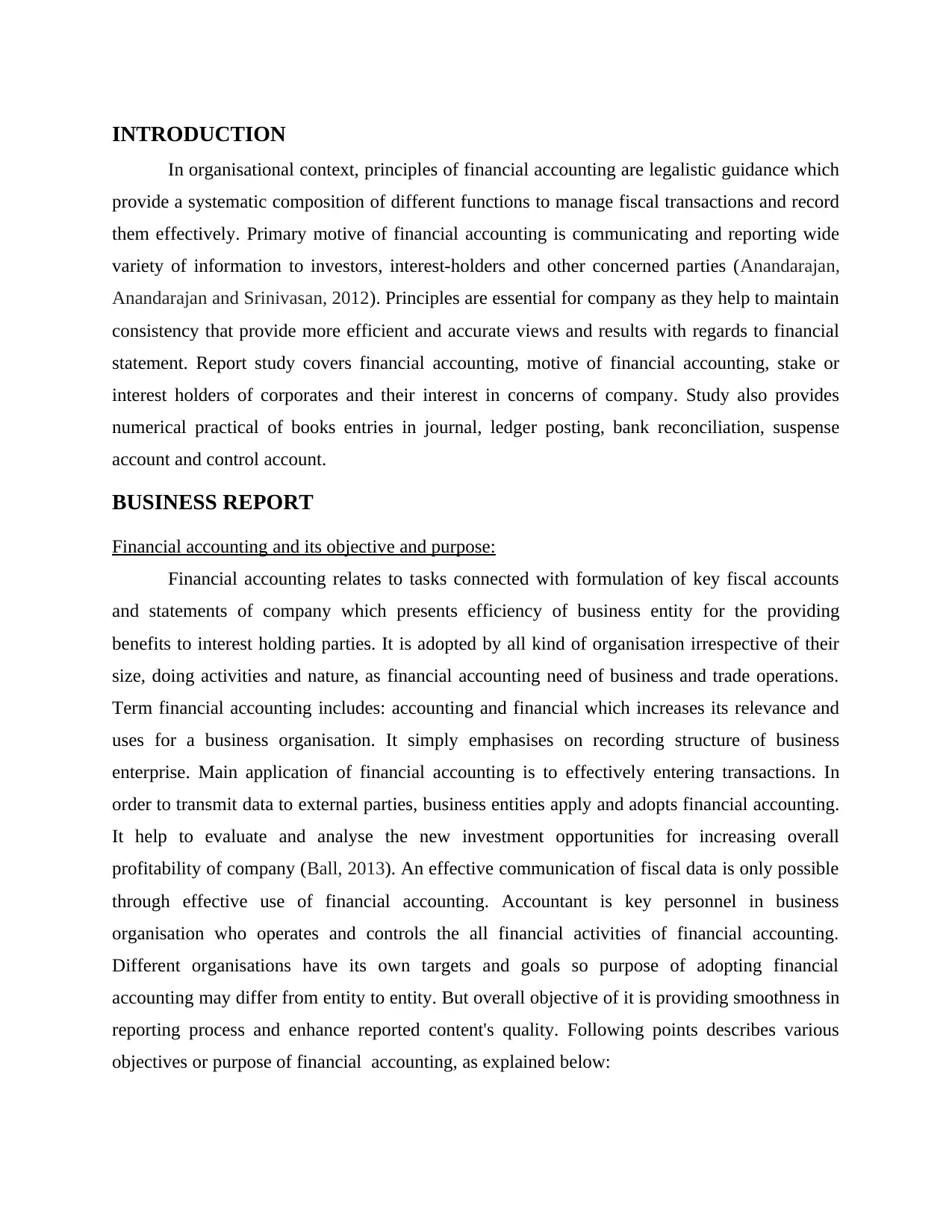
INTRODUCTION
In organisational context, principles of financial accounting are legalistic guidance which
provide a systematic composition of different functions to manage fiscal transactions and record
them effectively. Primary motive of financial accounting is communicating and reporting wide
variety of information to investors, interest-holders and other concerned parties (Anandarajan,
Anandarajan and Srinivasan, 2012). Principles are essential for company as they help to maintain
consistency that provide more efficient and accurate views and results with regards to financial
statement. Report study covers financial accounting, motive of financial accounting, stake or
interest holders of corporates and their interest in concerns of company. Study also provides
numerical practical of books entries in journal, ledger posting, bank reconciliation, suspense
account and control account.
BUSINESS REPORT
Financial accounting and its objective and purpose:
Financial accounting relates to tasks connected with formulation of key fiscal accounts
and statements of company which presents efficiency of business entity for the providing
benefits to interest holding parties. It is adopted by all kind of organisation irrespective of their
size, doing activities and nature, as financial accounting need of business and trade operations.
Term financial accounting includes: accounting and financial which increases its relevance and
uses for a business organisation. It simply emphasises on recording structure of business
enterprise. Main application of financial accounting is to effectively entering transactions. In
order to transmit data to external parties, business entities apply and adopts financial accounting.
It help to evaluate and analyse the new investment opportunities for increasing overall
profitability of company (Ball, 2013). An effective communication of fiscal data is only possible
through effective use of financial accounting. Accountant is key personnel in business
organisation who operates and controls the all financial activities of financial accounting.
Different organisations have its own targets and goals so purpose of adopting financial
accounting may differ from entity to entity. But overall objective of it is providing smoothness in
reporting process and enhance reported content's quality. Following points describes various
objectives or purpose of financial accounting, as explained below:
In organisational context, principles of financial accounting are legalistic guidance which
provide a systematic composition of different functions to manage fiscal transactions and record
them effectively. Primary motive of financial accounting is communicating and reporting wide
variety of information to investors, interest-holders and other concerned parties (Anandarajan,
Anandarajan and Srinivasan, 2012). Principles are essential for company as they help to maintain
consistency that provide more efficient and accurate views and results with regards to financial
statement. Report study covers financial accounting, motive of financial accounting, stake or
interest holders of corporates and their interest in concerns of company. Study also provides
numerical practical of books entries in journal, ledger posting, bank reconciliation, suspense
account and control account.
BUSINESS REPORT
Financial accounting and its objective and purpose:
Financial accounting relates to tasks connected with formulation of key fiscal accounts
and statements of company which presents efficiency of business entity for the providing
benefits to interest holding parties. It is adopted by all kind of organisation irrespective of their
size, doing activities and nature, as financial accounting need of business and trade operations.
Term financial accounting includes: accounting and financial which increases its relevance and
uses for a business organisation. It simply emphasises on recording structure of business
enterprise. Main application of financial accounting is to effectively entering transactions. In
order to transmit data to external parties, business entities apply and adopts financial accounting.
It help to evaluate and analyse the new investment opportunities for increasing overall
profitability of company (Ball, 2013). An effective communication of fiscal data is only possible
through effective use of financial accounting. Accountant is key personnel in business
organisation who operates and controls the all financial activities of financial accounting.
Different organisations have its own targets and goals so purpose of adopting financial
accounting may differ from entity to entity. But overall objective of it is providing smoothness in
reporting process and enhance reported content's quality. Following points describes various
objectives or purpose of financial accounting, as explained below:
⊘ This is a preview!⊘
Do you want full access?
Subscribe today to unlock all pages.

Trusted by 1+ million students worldwide
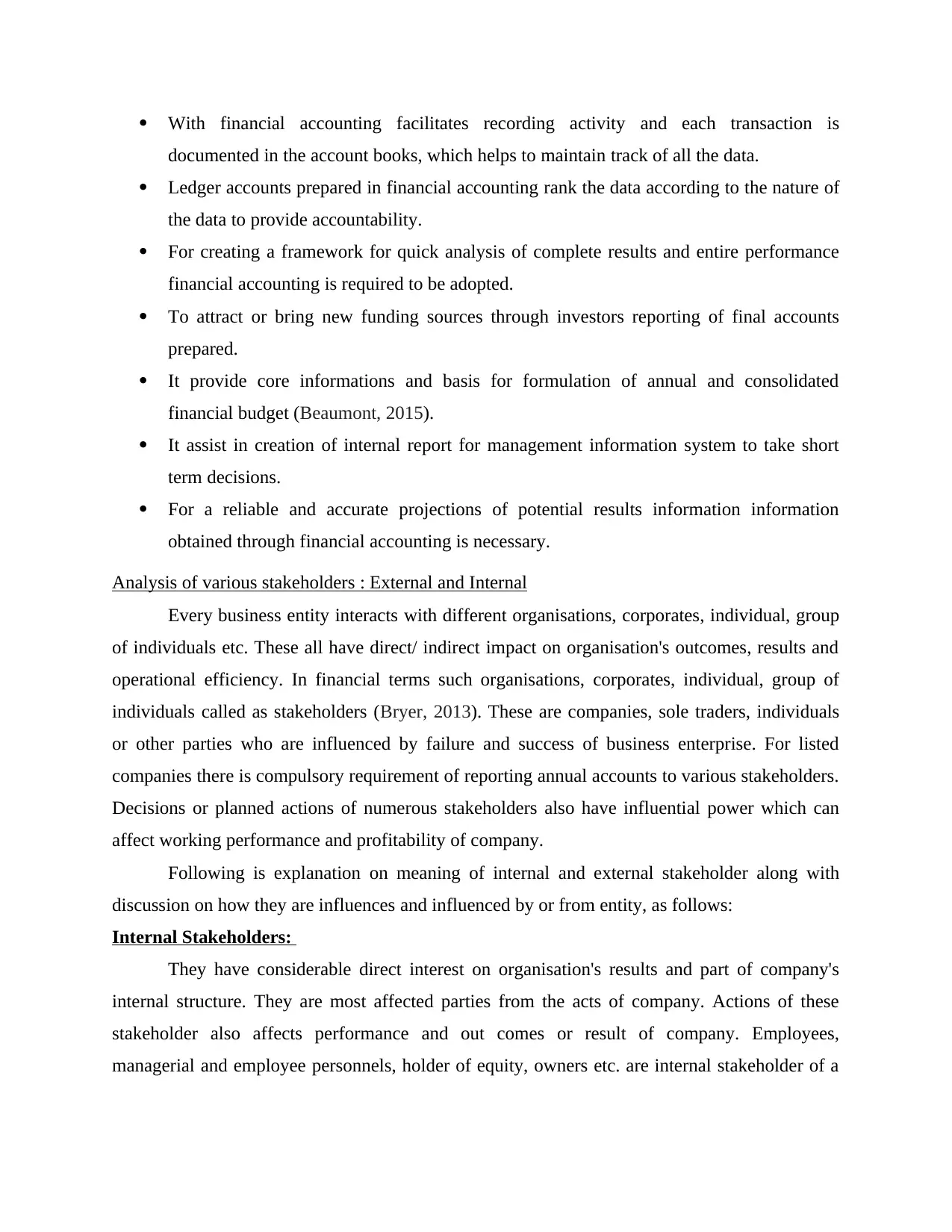
With financial accounting facilitates recording activity and each transaction is
documented in the account books, which helps to maintain track of all the data.
Ledger accounts prepared in financial accounting rank the data according to the nature of
the data to provide accountability.
For creating a framework for quick analysis of complete results and entire performance
financial accounting is required to be adopted.
To attract or bring new funding sources through investors reporting of final accounts
prepared.
It provide core informations and basis for formulation of annual and consolidated
financial budget (Beaumont, 2015).
It assist in creation of internal report for management information system to take short
term decisions.
For a reliable and accurate projections of potential results information information
obtained through financial accounting is necessary.
Analysis of various stakeholders : External and Internal
Every business entity interacts with different organisations, corporates, individual, group
of individuals etc. These all have direct/ indirect impact on organisation's outcomes, results and
operational efficiency. In financial terms such organisations, corporates, individual, group of
individuals called as stakeholders (Bryer, 2013). These are companies, sole traders, individuals
or other parties who are influenced by failure and success of business enterprise. For listed
companies there is compulsory requirement of reporting annual accounts to various stakeholders.
Decisions or planned actions of numerous stakeholders also have influential power which can
affect working performance and profitability of company.
Following is explanation on meaning of internal and external stakeholder along with
discussion on how they are influences and influenced by or from entity, as follows:
Internal Stakeholders:
They have considerable direct interest on organisation's results and part of company's
internal structure. They are most affected parties from the acts of company. Actions of these
stakeholder also affects performance and out comes or result of company. Employees,
managerial and employee personnels, holder of equity, owners etc. are internal stakeholder of a
documented in the account books, which helps to maintain track of all the data.
Ledger accounts prepared in financial accounting rank the data according to the nature of
the data to provide accountability.
For creating a framework for quick analysis of complete results and entire performance
financial accounting is required to be adopted.
To attract or bring new funding sources through investors reporting of final accounts
prepared.
It provide core informations and basis for formulation of annual and consolidated
financial budget (Beaumont, 2015).
It assist in creation of internal report for management information system to take short
term decisions.
For a reliable and accurate projections of potential results information information
obtained through financial accounting is necessary.
Analysis of various stakeholders : External and Internal
Every business entity interacts with different organisations, corporates, individual, group
of individuals etc. These all have direct/ indirect impact on organisation's outcomes, results and
operational efficiency. In financial terms such organisations, corporates, individual, group of
individuals called as stakeholders (Bryer, 2013). These are companies, sole traders, individuals
or other parties who are influenced by failure and success of business enterprise. For listed
companies there is compulsory requirement of reporting annual accounts to various stakeholders.
Decisions or planned actions of numerous stakeholders also have influential power which can
affect working performance and profitability of company.
Following is explanation on meaning of internal and external stakeholder along with
discussion on how they are influences and influenced by or from entity, as follows:
Internal Stakeholders:
They have considerable direct interest on organisation's results and part of company's
internal structure. They are most affected parties from the acts of company. Actions of these
stakeholder also affects performance and out comes or result of company. Employees,
managerial and employee personnels, holder of equity, owners etc. are internal stakeholder of a
Paraphrase This Document
Need a fresh take? Get an instant paraphrase of this document with our AI Paraphraser
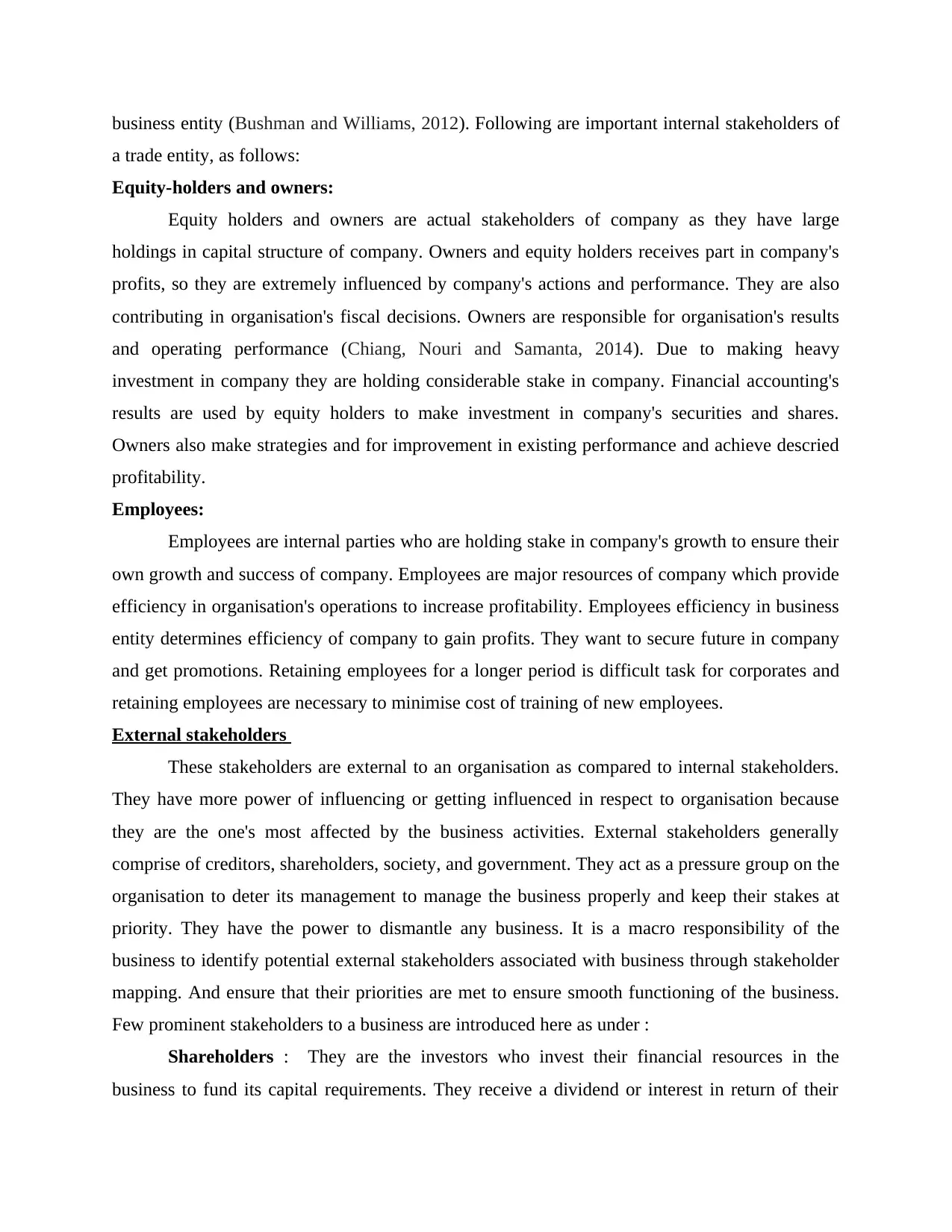
business entity (Bushman and Williams, 2012). Following are important internal stakeholders of
a trade entity, as follows:
Equity-holders and owners:
Equity holders and owners are actual stakeholders of company as they have large
holdings in capital structure of company. Owners and equity holders receives part in company's
profits, so they are extremely influenced by company's actions and performance. They are also
contributing in organisation's fiscal decisions. Owners are responsible for organisation's results
and operating performance (Chiang, Nouri and Samanta, 2014). Due to making heavy
investment in company they are holding considerable stake in company. Financial accounting's
results are used by equity holders to make investment in company's securities and shares.
Owners also make strategies and for improvement in existing performance and achieve descried
profitability.
Employees:
Employees are internal parties who are holding stake in company's growth to ensure their
own growth and success of company. Employees are major resources of company which provide
efficiency in organisation's operations to increase profitability. Employees efficiency in business
entity determines efficiency of company to gain profits. They want to secure future in company
and get promotions. Retaining employees for a longer period is difficult task for corporates and
retaining employees are necessary to minimise cost of training of new employees.
External stakeholders
These stakeholders are external to an organisation as compared to internal stakeholders.
They have more power of influencing or getting influenced in respect to organisation because
they are the one's most affected by the business activities. External stakeholders generally
comprise of creditors, shareholders, society, and government. They act as a pressure group on the
organisation to deter its management to manage the business properly and keep their stakes at
priority. They have the power to dismantle any business. It is a macro responsibility of the
business to identify potential external stakeholders associated with business through stakeholder
mapping. And ensure that their priorities are met to ensure smooth functioning of the business.
Few prominent stakeholders to a business are introduced here as under :
Shareholders : They are the investors who invest their financial resources in the
business to fund its capital requirements. They receive a dividend or interest in return of their
a trade entity, as follows:
Equity-holders and owners:
Equity holders and owners are actual stakeholders of company as they have large
holdings in capital structure of company. Owners and equity holders receives part in company's
profits, so they are extremely influenced by company's actions and performance. They are also
contributing in organisation's fiscal decisions. Owners are responsible for organisation's results
and operating performance (Chiang, Nouri and Samanta, 2014). Due to making heavy
investment in company they are holding considerable stake in company. Financial accounting's
results are used by equity holders to make investment in company's securities and shares.
Owners also make strategies and for improvement in existing performance and achieve descried
profitability.
Employees:
Employees are internal parties who are holding stake in company's growth to ensure their
own growth and success of company. Employees are major resources of company which provide
efficiency in organisation's operations to increase profitability. Employees efficiency in business
entity determines efficiency of company to gain profits. They want to secure future in company
and get promotions. Retaining employees for a longer period is difficult task for corporates and
retaining employees are necessary to minimise cost of training of new employees.
External stakeholders
These stakeholders are external to an organisation as compared to internal stakeholders.
They have more power of influencing or getting influenced in respect to organisation because
they are the one's most affected by the business activities. External stakeholders generally
comprise of creditors, shareholders, society, and government. They act as a pressure group on the
organisation to deter its management to manage the business properly and keep their stakes at
priority. They have the power to dismantle any business. It is a macro responsibility of the
business to identify potential external stakeholders associated with business through stakeholder
mapping. And ensure that their priorities are met to ensure smooth functioning of the business.
Few prominent stakeholders to a business are introduced here as under :
Shareholders : They are the investors who invest their financial resources in the
business to fund its capital requirements. They receive a dividend or interest in return of their
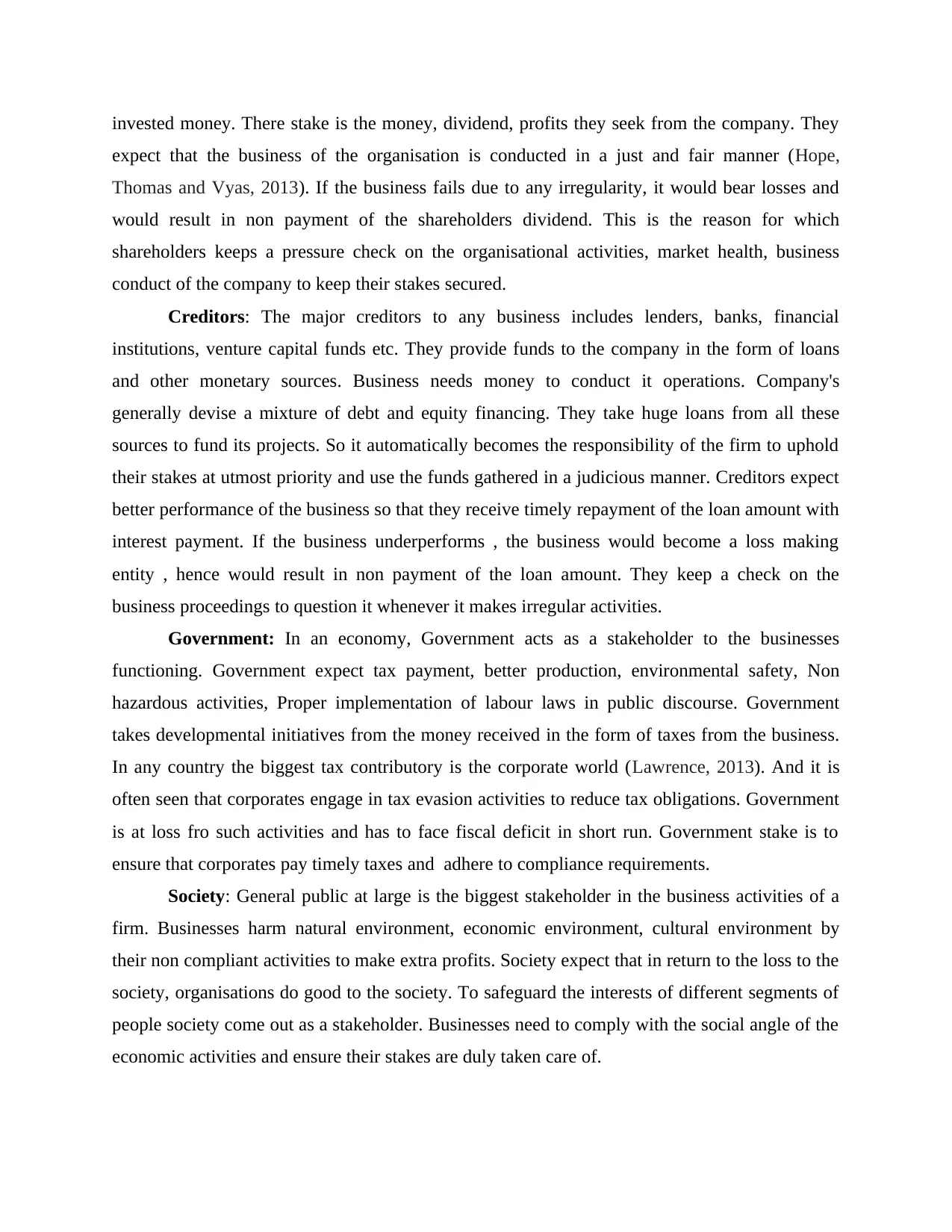
invested money. There stake is the money, dividend, profits they seek from the company. They
expect that the business of the organisation is conducted in a just and fair manner (Hope,
Thomas and Vyas, 2013). If the business fails due to any irregularity, it would bear losses and
would result in non payment of the shareholders dividend. This is the reason for which
shareholders keeps a pressure check on the organisational activities, market health, business
conduct of the company to keep their stakes secured.
Creditors: The major creditors to any business includes lenders, banks, financial
institutions, venture capital funds etc. They provide funds to the company in the form of loans
and other monetary sources. Business needs money to conduct it operations. Company's
generally devise a mixture of debt and equity financing. They take huge loans from all these
sources to fund its projects. So it automatically becomes the responsibility of the firm to uphold
their stakes at utmost priority and use the funds gathered in a judicious manner. Creditors expect
better performance of the business so that they receive timely repayment of the loan amount with
interest payment. If the business underperforms , the business would become a loss making
entity , hence would result in non payment of the loan amount. They keep a check on the
business proceedings to question it whenever it makes irregular activities.
Government: In an economy, Government acts as a stakeholder to the businesses
functioning. Government expect tax payment, better production, environmental safety, Non
hazardous activities, Proper implementation of labour laws in public discourse. Government
takes developmental initiatives from the money received in the form of taxes from the business.
In any country the biggest tax contributory is the corporate world (Lawrence, 2013). And it is
often seen that corporates engage in tax evasion activities to reduce tax obligations. Government
is at loss fro such activities and has to face fiscal deficit in short run. Government stake is to
ensure that corporates pay timely taxes and adhere to compliance requirements.
Society: General public at large is the biggest stakeholder in the business activities of a
firm. Businesses harm natural environment, economic environment, cultural environment by
their non compliant activities to make extra profits. Society expect that in return to the loss to the
society, organisations do good to the society. To safeguard the interests of different segments of
people society come out as a stakeholder. Businesses need to comply with the social angle of the
economic activities and ensure their stakes are duly taken care of.
expect that the business of the organisation is conducted in a just and fair manner (Hope,
Thomas and Vyas, 2013). If the business fails due to any irregularity, it would bear losses and
would result in non payment of the shareholders dividend. This is the reason for which
shareholders keeps a pressure check on the organisational activities, market health, business
conduct of the company to keep their stakes secured.
Creditors: The major creditors to any business includes lenders, banks, financial
institutions, venture capital funds etc. They provide funds to the company in the form of loans
and other monetary sources. Business needs money to conduct it operations. Company's
generally devise a mixture of debt and equity financing. They take huge loans from all these
sources to fund its projects. So it automatically becomes the responsibility of the firm to uphold
their stakes at utmost priority and use the funds gathered in a judicious manner. Creditors expect
better performance of the business so that they receive timely repayment of the loan amount with
interest payment. If the business underperforms , the business would become a loss making
entity , hence would result in non payment of the loan amount. They keep a check on the
business proceedings to question it whenever it makes irregular activities.
Government: In an economy, Government acts as a stakeholder to the businesses
functioning. Government expect tax payment, better production, environmental safety, Non
hazardous activities, Proper implementation of labour laws in public discourse. Government
takes developmental initiatives from the money received in the form of taxes from the business.
In any country the biggest tax contributory is the corporate world (Lawrence, 2013). And it is
often seen that corporates engage in tax evasion activities to reduce tax obligations. Government
is at loss fro such activities and has to face fiscal deficit in short run. Government stake is to
ensure that corporates pay timely taxes and adhere to compliance requirements.
Society: General public at large is the biggest stakeholder in the business activities of a
firm. Businesses harm natural environment, economic environment, cultural environment by
their non compliant activities to make extra profits. Society expect that in return to the loss to the
society, organisations do good to the society. To safeguard the interests of different segments of
people society come out as a stakeholder. Businesses need to comply with the social angle of the
economic activities and ensure their stakes are duly taken care of.
⊘ This is a preview!⊘
Do you want full access?
Subscribe today to unlock all pages.

Trusted by 1+ million students worldwide
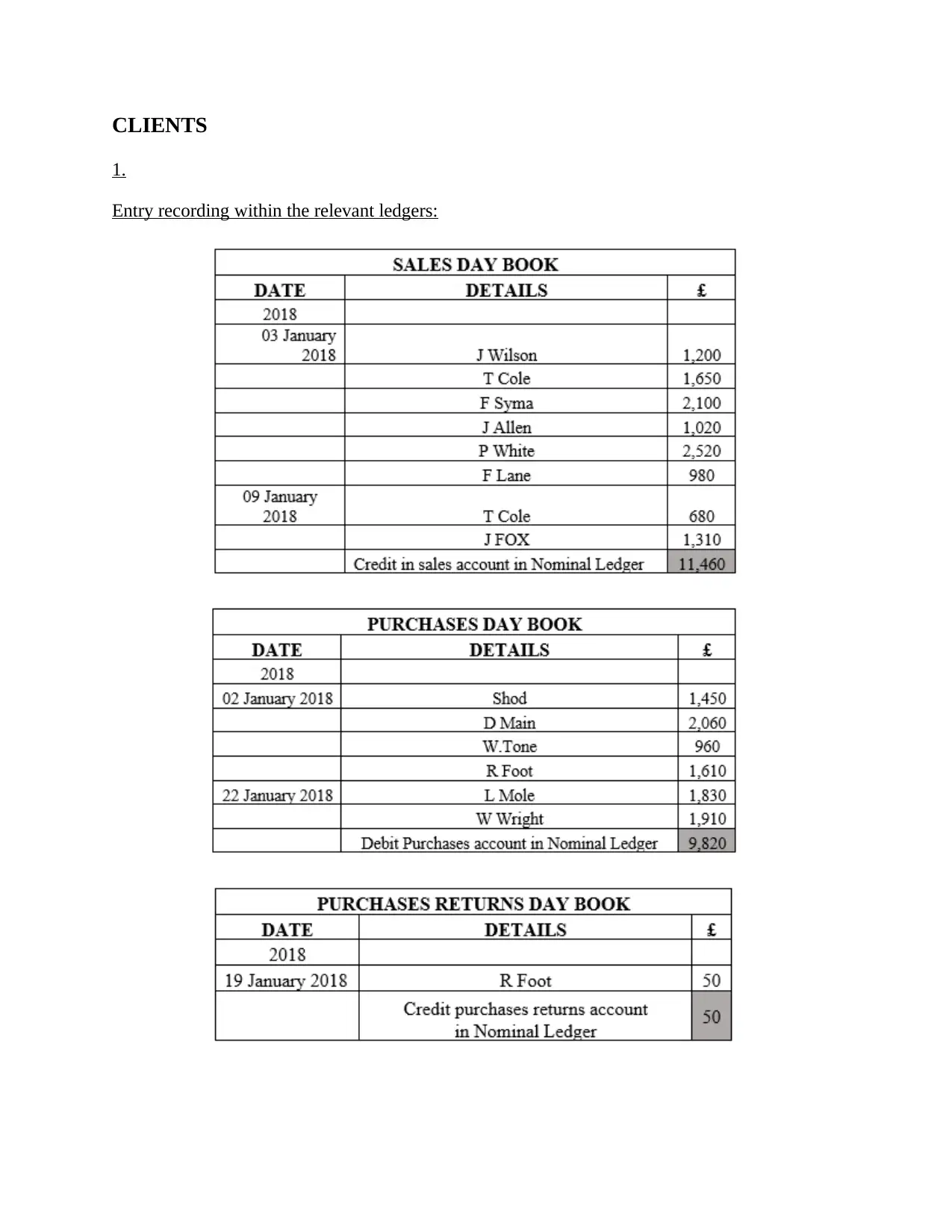
CLIENTS
1.
Entry recording within the relevant ledgers:
1.
Entry recording within the relevant ledgers:
Paraphrase This Document
Need a fresh take? Get an instant paraphrase of this document with our AI Paraphraser
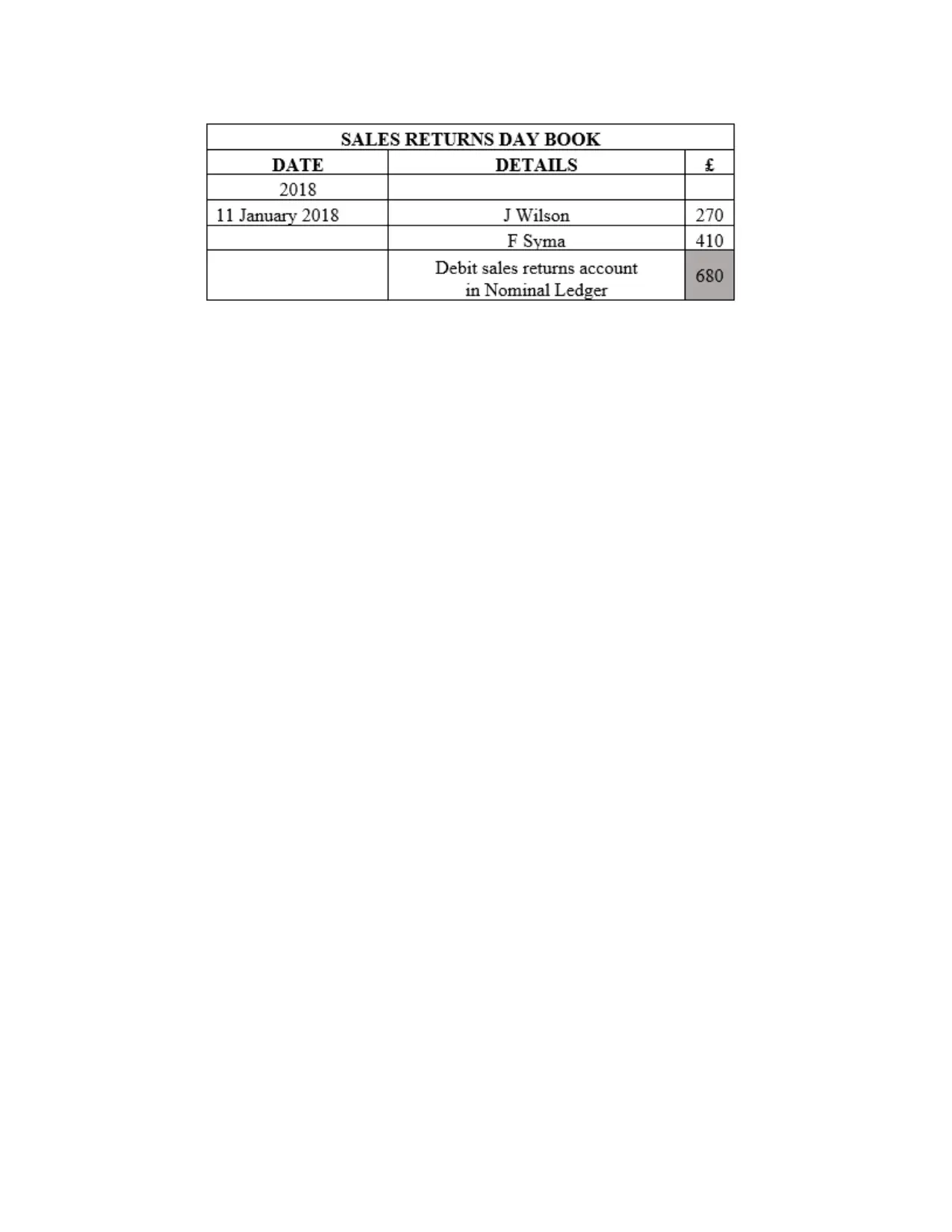
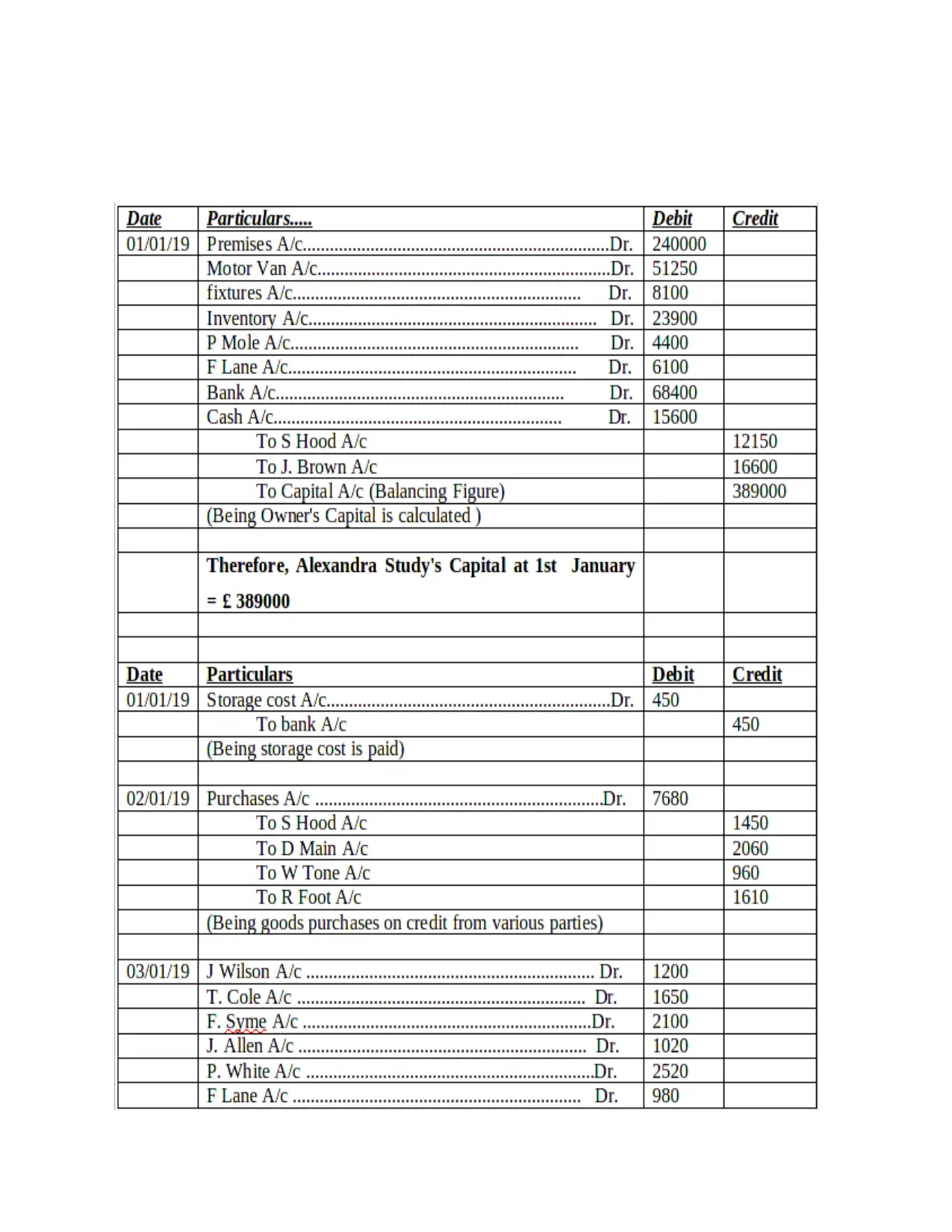
⊘ This is a preview!⊘
Do you want full access?
Subscribe today to unlock all pages.

Trusted by 1+ million students worldwide
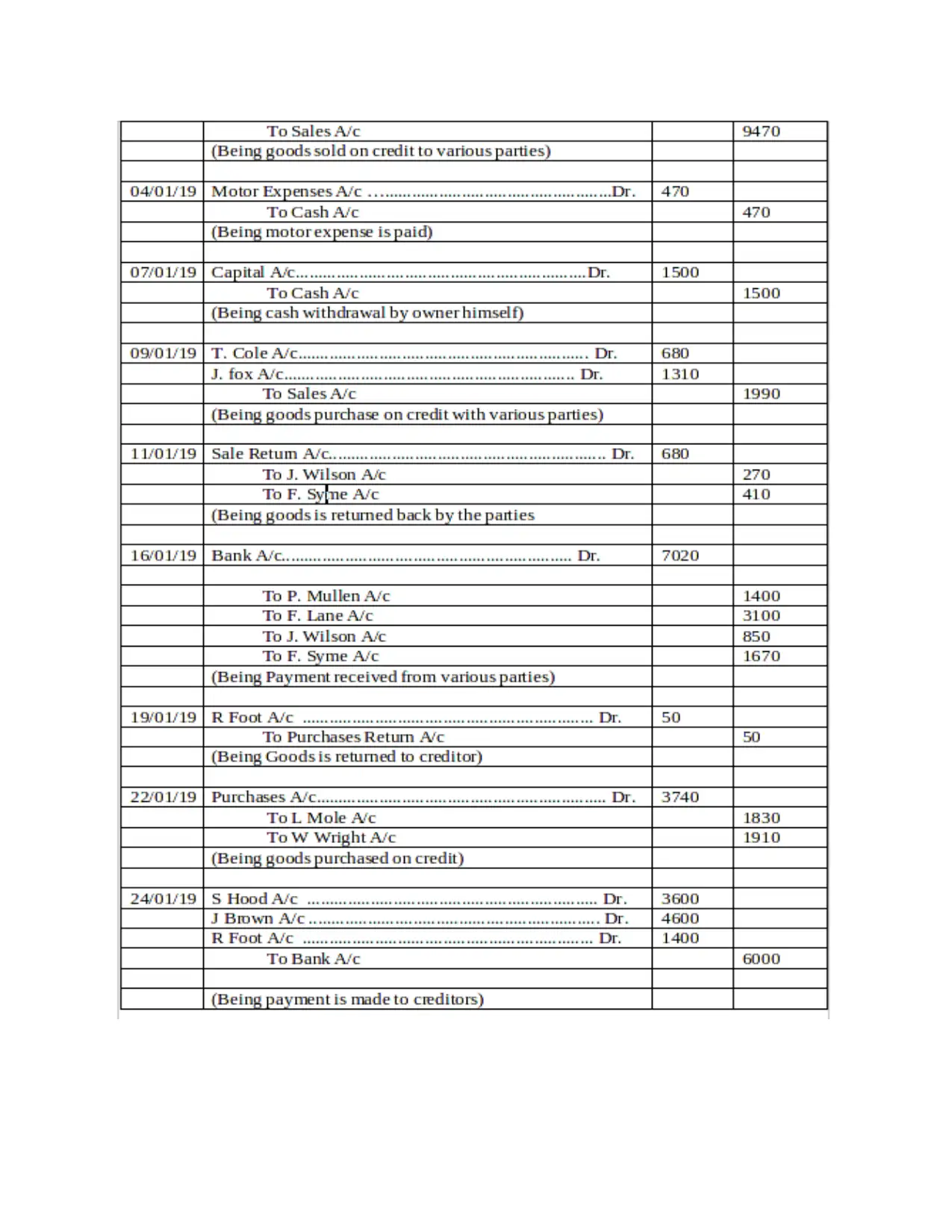
Paraphrase This Document
Need a fresh take? Get an instant paraphrase of this document with our AI Paraphraser
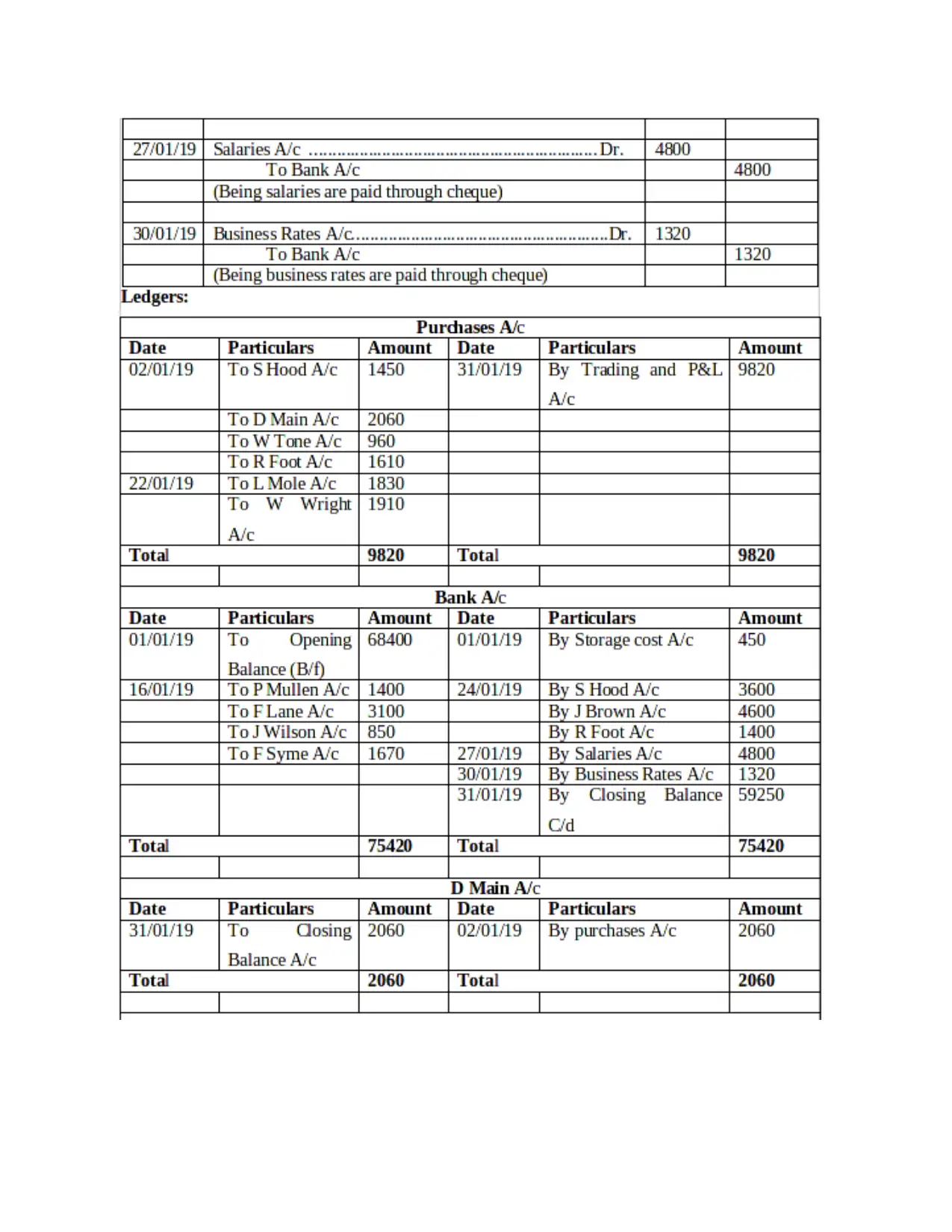
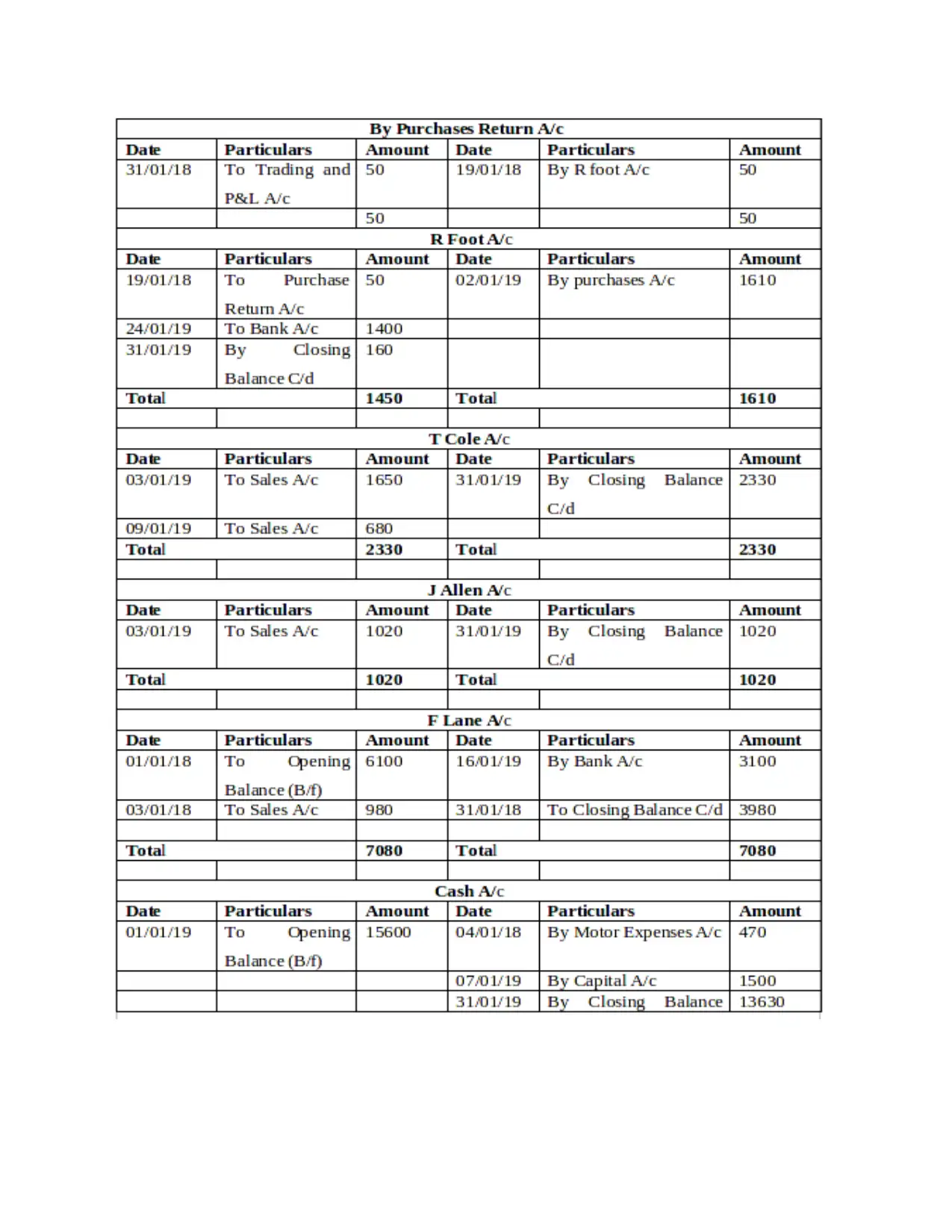
⊘ This is a preview!⊘
Do you want full access?
Subscribe today to unlock all pages.

Trusted by 1+ million students worldwide
1 out of 27
Related Documents
Your All-in-One AI-Powered Toolkit for Academic Success.
+13062052269
info@desklib.com
Available 24*7 on WhatsApp / Email
![[object Object]](/_next/static/media/star-bottom.7253800d.svg)
Unlock your academic potential
Copyright © 2020–2025 A2Z Services. All Rights Reserved. Developed and managed by ZUCOL.




